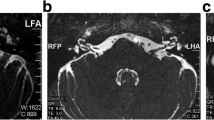Abstract
The purpose of this study was to assess the value of a long echo-train-length 3D fast spin-echo (3D-FSE) sequence in visualizing the inner ear structures. Ten normal ears and 50 patient ears were imaged on a 1.5T MR unit using a head coil. Axial high-resolution T2-weighted images of the inner ear and the internal auditory canal (IAC) were obtained in 15 min. In normal ears the reliability of the visualization for the inner ear structures was evaluated on original images and the targeted maximum intensity projection (MIP) images of the labyrinth. In ten normal ears, 3D surface display (3D) images were also created and compared with MIP images. On the original images the cochlear aqueduct, the vessels in the vicinity of the IAC, and more than three branches of the cranial nerves were visualized in the AIC in all the ears. The visibility of the endolympathic duct was 80%. On the MIP images the visibility of the three semicircular canals, anterior and posterior ampulla, and of more than two turns of the cochlea was 100%. The MIP images and 3D images were almost comparable. The visibility of the endolymphatic duct was 80% in normal ears and 0% in the affected ears of the patients with Meniere's disease (p < 0.01). In one patient ear a small intracanalicular tumor was depicted clearly. In conclusion, the long echo train length T2-weighted 3D-FSE sequence enables the detailed visualization of the tiny structures of the inner ear and the IAC within a clinically acceptable scan time. Furthermore, obtaining a high contrast between the soft/bony tissue and the cerebrospinal/endolymph/perilymph fluid would be of significant value in the diagnoses of the pathologic conditions around the labyrinth and the IAC.
Similar content being viewed by others
References
Takehara Y, Ichijo K, Tohyama N et al. (1993) MR cisternography using “Long echo train length fast spin echo sequence” for demonstrating the inner ear. Nippon Acta Radiol 53: 859–861.
Phalps PD (1994) Fasst spin echo in otology. J Laryngol Otol 108: 383–394.
Tanioka H, Shirakawa T, Machida T, Sasaki Y (1991) Three-dimensional reconstructed MR imaging of the inner ear. Radiology 178: 141–144.
Stillman AE, Remley K, Loes DJ et al. (1994) Steady-state free procession imaging of the inner ear. AJNR 15: 348–350.
Caselman JW, Kuhweide R, Deimling M et al. (1993) Constructive interference in steady state-3DFT MR imaging of the inner ear and cerebellopontine angle. AJNR 14: 47–57.
Tien RD, Feisberg GJ, MacFall J (1992) Fast spin-echo high resolution MR imaging of the inner ear. AJR 159: 395–398.
Casselman JW, Kuhweide R, Ampe W, Devlies F (1994) Magnetic resonance examination of the inner ear and cerebellopontine angle in patients with vertigo and/or abnormal findings at vestibular testing. Acta Otolaryngol (Stockh) 513 (Suppl): 15–27.
Valvassori GE (1994) Update of computed tomography and magnetic resonance in otology. Am J Otol 15: 203–206.
Tien RD, Felsberg GJ, MacFall J (1993) Three dimensional MR gradient recalled echo imaging of the inner ear: comparison of FID and echo imaging techniques. Magn Reson Imaging 11: 429–435.
Japanese welfare clinical criteria (1988) Diagnosis of Meniere's disease. Today's diagnosis, 2nd edn. Igakushoin, Tokyo, p. 1363.
Kramer D, Li A, Simovsky I, Hawaryszko C, Hale J, Kaufman L (1990) Application of voxel shifting in magnetic resonance imaging. Invest Radiol 25: 1305–1310.
Du YP, Parker DL, Davis WL, Cao G (1994) Reduction of partial-volume artifacts with zerofilled interpolation in three-dimensional MR angiography. JMRI 4: 733–741.
Tanioka H, Zusho H, Sasaki Y, Shirakawa T (1992) High-resolution MR imaging of the inner ear: finding in Meniere's disease. Eur J Radiol 15: 83–88.
Naganawa S, Asai H, Ishigaki T, Sakuma S (1991) MR imaging of the vestibular aqueduct in normal volunteers and patients with Meniere's disease — a preliminary report. Nippon Acta Radiol 51: 213–218.
Suzuki T, Nakashima T, Naganawa S, Yanakita N et al. (1992) Magnetic resonance imaging of the endolymphatic duct and sac in Meniere's disease. Auris-Nasus-Larynx (Tokyo) 19 (Suppl 1): 81–87.
Brogan M, Chakeres DW, Schmalbrock P (1991) High-resolution 3DFT MR imaging of the endolymphatic duct and soft tissue of the otic capsule. AJNR 12: 1–11.
Esfahani F, Dolan K (1989) Air CT cisternography in the diagnosis of the vascular loop causing vestibular nerve dysfunction. AJNR 10: 1045–1049.
Kumakawa K, Takeda H, Mutoh N, Miyakawa K, Yukawa K, Funasaka S (1992) Image analysis of the inner ear with CT and MR imaging: pre-operative assessment for cochlear implant surgery. Nippon-Jibiinkoka-Gakkai-Kaiho 95: 817–824.
Seidman DA, Chute PM, Parisier S (1994) Temporal bone imaging for cochlear implantation. Laryngoscope 104: 562–565.
Seltzer S, Mark AS (1991) Contrast enhancement of the labyrinth on MR scans in patients with sudden hearing loss and vertigo: evidence of labyrinthine disease. AJNR 12: 13–16.
Brogan M, Chakeres DW (1990) Gd-DTPA-enhanced MR imaging of cochlear schwannoma. AJNR 11: 407–408.
Doyle KJ, Brackmann DE (1994) Intralabyrinthine schwannomas. Otolaryngol Head Neck Surg 110: 517–525.
Weed DT, Teague MW, Stewart R, Schwaber MK (1994) Intralabyrinthine schwannoma: a case report. Otolaryngol Head Neck Surg 111: 134–142.
Naganawa S, Senda K, Ishigaki T t al. (1995) High resolution MR imaging of the inner ear apparatus using 3D-fast spin echo sequence. Nippon Acta Radiol 55: 81–82.
Author information
Authors and Affiliations
Additional information
Correspondence to: S. Naganawa
Rights and permissions
About this article
Cite this article
Naganawa, S., Yamakawa, K., Fukatsu, H. et al. High-resolution T2-weighted MR imaging of the inner ear using a long echo-train-length 3D fast spin-echo sequence. Eur. Radiol. 6, 369–374 (1996). https://doi.org/10.1007/BF00180615
Received:
Revised:
Accepted:
Issue Date:
DOI: https://doi.org/10.1007/BF00180615




